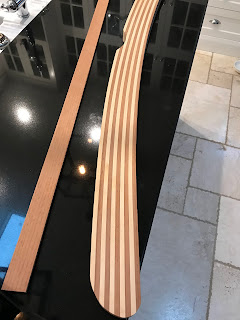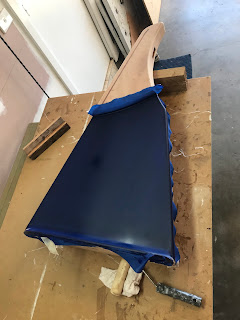I've had a spell from glassing the cockpit by digressing to other sections of the yacht. But I have put it off long enough, so back to laying glass cloth.
Contact Email
Sunday, December 22, 2024
Glassing the Cockpit (Cont.)
Sunday, December 8, 2024
Boom Gallows
To keep the weight down I will laminate western red cedar (which is very light timber) with hoop pine for the boom gallows. The red colored cedar will look nice laminated next to the light-colored hoop pine.
There will be a total of 11 laminations each measuring 8mm in thickness which will make the gallows strong.
I will also drill vertical holes through the laminations to further reduce weight.
An outline of the boom gallows is drawn onto a piece of scrap board and timber blocks screwed along the bottom edge to clamp the laminations in place.
Time to make some dust.
I milled this........
Into this.......
Ten of the eleven lamination strips are glued and clamped to the plastic covered clamping board.
The 11th, top strip will be glued on later after I drill the vertical holes to reduce the gallows weight.
After removing the clamps and plastic I cleaned the epoxy squeeze with a large disc sander before running the section through a thicknesser.
And here is the cleaned-up and shaped section. I rough shaped the ends with a jig saw and cleaned them up with a belt sander.
Time to drill the 25mm diam. holes for the boom gallows support tubes. I used a Forstner bit in a bench drill.
As I mentioned earlier to reduce weight, I drilled twenty-six 20mm diam. holes vertically into the gallows from the top.
I didn't weigh the section prior to drilling the holes but the section feels quite light without compromising strength. (I hope)
The top laminate is glued in place covering up the holes.
The top laminate is cleaned up, trimmed and the edges routed. Holes are drilled for rope to secure the mast. The first coat of epoxy is applied.
Sunday, December 1, 2024
Tiller Time
I liked the look of a laminated tiller. Using blue gum and hoop pine provided a nice contrasting color of the red colored blue gum next to the light-colored hoop pine.
The tiller plan is covered with plastic and clamping blocks screwed along the upper curve of the tiller's length.
The laminates are milled to 6.5 mm thick sections. A dry fit of the timbers is clamped in place to ensure the timber bends OK with no surprises.
The laminates are glued and clamped in place. Upper timber blocks are screwed down to ensure the sections are held down flat and prevent any twisting.
After leaving the tiller overnight I ran it through a thicknesser down to 18mm.
Edges routed next and the complete unit sanded to a smooth finish.
Sunday, November 17, 2024
Porthole Installation.
I decided to decorate the outside and inside surrounds of the porthole windows using 9mm thick plywood rings.
I made the rings large enough to overlap the 6mm marine acrylic portholes. The outside rings will be permanently epoxied in place and the portholes will be sealed and screwed in place with marine bedding compound from the inside. The inside rings will be screwed over the acrylic porthole window (This will allow future replacement if required).
This pic shows the 6mm marine acrylic porthole with protective covering alongside the drawing of the decorative ring.
Using a jigsaw, I cut out the rings and cleaned up with a bench sander and a circular drum sander.
Here are the eight decorative porthole rings ready for edge routing.
BUT, I had a change of plans. I decided to use hoop pine for the four outer rings. I thought this would look better and follow the bright timber theme, so now I have four plywood porthole rings spare.
Time to make some dust. I cut the hoop pine rings from a thicker piece of timber. I cut a square block slightly larger than the ring circumference and ran the four sides of the block over the table saw blade. As the blade was not deep enough to cut all the way through the block the remaining center section was cut with a Japanese saw.
Here are the completed porthole rings, the four exteriors from hoop pine and the four interiors from 9mm plywood. All rings are given 3 coats of epoxy prior to several coats of polyurethane.
The holes are cut out of the cabin walls with a jig saw. Several coats of epoxy are applied around the area where the porthole rings will be attached. I will smooth this area prior to gluing on the porthole rings. It will be much easier than sanding around the rings when in place.
Thickened epoxy is applied to the port hull side.
The rings are clamped in place, epoxy squeeze out is cleaned up and the masking tape removed.
Starboard rings are masked up in preparation for fitting.
Hull side also marked up
Rings are glued and clamped in place.
Glassing the Cockpit (Cont)
Thursday, October 10, 2024
Rub Rails
Rub Rails:
I decided to use blue gum hardwood with the lighter colored hoop pine laminated in-between for the rub rails. But, 18mm thick blue gum will not bend easily around the forward section of the hull without breaking and it would require too many hours in my homemade steamer to soften up enough to make the bend. Also I only had enough stock to complete the rub rails and couldn't afford any breakages.......Sooooo, I decided to halve each section to 9mm thick and laminate them in place. This required a lot more labor (A total of 6 laminations per side), but the thinner timbers bent easily and smoothly around the hull, and I think the laminations will look nice.
Time to make some dust and mill up some blue gum hardwood floorboards and hoop pine into 9mm strips.
Time to turn floorboard planks from this........
Into this..........
The rub rails needed to be 5m long, the floorboards were not long enough and required scarfing.
A 90mm cut gave a one in ten scarf.
The scarfed sections are glued and held in place with clamps alongside a large aluminum straight edge.
A port view of the first 9mm blue gum laminate temporarily screwed and glued in place.
After the second blue gum laminate it was time for the contrasting hoop pine laminates. Again, I milled the hoop pine into 9mm thickness to smoothly bend without any risk of breaking.
Fortunately, the hoop pine lengths I had in stock were long enough and did not require scarfing.
After the second hoop pine laminate it was time for the last of the blue gum laminates.
This bow view shows the 5th blue gum laminate, one more to go.
I'm not sure if I will leave the very front nose section as shown in the pic with the laminates overlapping to a point or cut it off square along the front as per the plan.
(after all its covered up by the bowsprit)
I'll have to sleep on this one.
This pic shows the six, 9mm laminates finally glued in place.
And here is the port side cleaned up.
Firstly, I used a belt sander with 80 grit sandpaper to clean up the epoxy squeeze and level down the laminates.
Then I rounded the aft end to a smooth curve into the aft hull side.
A curve was routed along the top edge of the entire length prior to sanding smooth with an orbital sander using 240 grit.
I have to admit this was a very labor-intensive way of installing the rub rails, however the finish product speaks for itself. Using 9mm thick laminates prevented any breakage or splintering of the hardwood when bending around the bow section.
After removing the screws, I plugged all the holes.

Rudder / Glassing and peel ply
Fiberglass cloth smoothed over the lower sections.
Peel ply smoothed over the glass, this will leave a clean smooth surface and not require too much sanding.
For extra abrasion protection I laid two layers of glass cloth to the underside of the foot and finished with peel ply.
I just love peel ply, once removed it leaves an amine blush free super smooth finish...........did I say I love peel ply?
After filling and sanding a few imperfections, it was time to apply some epoxy coats.
I used a foam roller and applied two coats wet on wet.


















































